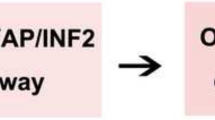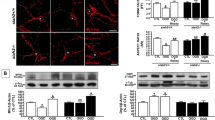Abstract
Neuroglobin (Ngb) is a tissue globin specifically expressed in brain neurons. Recent studies by our laboratory and others have demonstrated that Ngb is protective against stroke and related neurological disorders, but the mechanisms remain poorly understood. We previously identified cytochrome c1 (Cyc1) as an Ngb-interacting molecule by yeast two-hybrid screening. Cyc1 is a subunit of mitochondria complex III, which is a component of mitochondrial respiratory chain and a major source of reactive oxygen species (ROS) production under both physiological and pathological conditions. In this study, we for the first time defined Ngb-Cyc1 binding, and investigated its roles in oxygen-glucose deprivation (OGD)/reoxygenation-induced neurotoxicity and ROS production in primary neurons. Immunocytochemistry and co-immunoprecipitation validated Ngb-Cyc1 binding, which was significantly increased by OGD and Ngb overexpression. We found 4 h OGD with/without 4 h reoxygenation significantly increased complex III activity, but this activity elevation was significantly attenuated in three groups of neurons: Ngb overexpression, specific complex III inhibitor stigmatellin, or stigmatellin plus Ngb overexpression, whereas there was no significant differences between these three groups, suggesting Ngb-Cyc1 binding may function in suppressing OGD-mediated complex III activity elevation. Importantly, these three groups of neurons also showed significant decreases in OGD-induced superoxide anion generation and neurotoxicity. These results suggest that Ngb can bind to mitochondrial complex III subunit Cyc1, leading to suppression of OGD-mediated complex III activity and subsequent ROS production elevation, and eventually reduction of OGD-induced neurotoxicity. This molecular signaling cascade may be at least part of the mechanisms of Ngb neuroprotection against OGD-induced neurotoxicity.




Similar content being viewed by others
Abbreviations
- Ngb:
-
Neuroglobin
- NBM:
-
Neural basal medium
- OGD:
-
Oxygen-glucose deprivation
- LDH:
-
Lactate dehydrogenase
- ROS:
-
Reactive oxygen species
References
Burmester T, Weich B, Reinhardt S, Hankeln T (2000) A vertebrate globin expressed in the brain. Nature 407:520–523
Greenberg DA, Jin K, Khan AA (2008) Neuroglobin: an endogenous neuroprotectant. Curr Opin Pharmacol 8:20–24
Yu Z, Fan X, Lo EH, Wang X (2009) Neuroprotective roles and mechanisms of neuroglobin. Neurol Res 31:122–127
Burmester T, Hankeln T (2009) What is the function of neuroglobin? J Exp Biol 212:1423–1428
Wystub S, Laufs T, Schmidt M, Burmester T, Maas U, Saaler-Reinhardt S, Hankeln T, Reuss S (2003) Localization of neuroglobin protein in the mouse brain. Neurosci Lett 346:114–116
Jin K, Mao Y, Mao X, Xie L, Greenberg DA (2010) Neuroglobin expression in ischemic stroke. Stroke J Cereb Circ 41:557–559
Khan AA, Mao XO, Banwait S, Jin K, Greenberg DA (2007) Neuroglobin attenuates beta-amyloid neurotoxicity in vitro and transgenic Alzheimer phenotype in vivo. Proc Natl Acad Sci U S A 104:19114–19119
Wei X, Yu Z, Cho KS, Chen H, Malik MT, Chen X, Lo EH, Wang X et al (2011) Neuroglobin is an endogenous neuroprotectant for retinal ganglion cells against glaucomatous damage. Am J Pathol 179:2788–2797
Fordel E, Thijs L, Martinet W, Schrijvers D, Moens L, Dewilde S (2007) Anoxia or oxygen and glucose deprivation in SH-SY5Y cells: a step closer to the unraveling of neuroglobin and cytoglobin functions. Gene 398:114–122
Brunori M, Giuffre A, Nienhaus K, Nienhaus GU, Scandurra FM, Vallone B (2005) Neuroglobin, nitric oxide, and oxygen: functional pathways and conformational changes. Proc Natl Acad Sci U S A 102:8483–8488
Wakasugi K, Morishima I (2005) Preparation and characterization of a chimeric zebrafish-human neuroglobin engineered by module substitution. Biochem Biophys Res Commun 330:591–597
Li L, Liu QR, Xiong XX, Liu JM, Lai XJ, Cheng C, Pan F, Chen Y et al (2014) Neuroglobin promotes neurite outgrowth via differential binding to PTEN and Akt. Mol Neurobiol 49:149–162
Schmidt M, Giessl A, Laufs T, Hankeln T, Wolfrum U, Burmester T (2003) How does the eye breathe? Evidence for neuroglobin-mediated oxygen supply in the mammalian retina. J Biol Chem 278:1932–1935
Liu J, Yu Z, Guo S, Lee SR, Xing C, Zhang C, Gao Y, Nicholls DG et al (2009) Effects of neuroglobin overexpression on mitochondrial function and oxidative stress following hypoxia/reoxygenation in cultured neurons. J Neurosci Res 87:164–170
Yu Z, Liu N, Wang Y, Li X, Wang X (2012) Identification of neuroglobin-interacting proteins using yeast two-hybrid screening. Neuroscience 200:99–105
Yu Z, Liu N, Li Y, Xu J, Wang X (2013) Neuroglobin overexpression inhibits oxygen-glucose deprivation-induced mitochondrial permeability transition pore opening in primary cultured mouse cortical neurons. Neurobiol Dis 56:95–103
Nohl H, Hegner D (1978) Do mitochondria produce oxygen radicals in vivo? Eur J Biochem/FEBS 82:563–567
Guzy RD, Hoyos B, Robin E, Chen H, Liu L, Mansfield KD, Simon MC, Hammerling U et al (2005) Mitochondrial complex III is required for hypoxia-induced ROS production and cellular oxygen sensing. Cell Metab 1:401–408
Valencia A, Moran J (2004) Reactive oxygen species induce different cell death mechanisms in cultured neurons. Free Radic Biol Med 36:1112–1125
Sanderson TH, Reynolds CA, Kumar R, Przyklenk K, Huttemann M (2013) Molecular mechanisms of ischemia-reperfusion injury in brain: pivotal role of the mitochondrial membrane potential in reactive oxygen species generation. Mol Neurobiol 47:9–23
Yu Z, Xu J, Liu N, Wang Y, Li X, Pallast S, van Leyen K, Wang X (2012) Mitochondrial distribution of neuroglobin and its response to oxygen-glucose deprivation in primary-cultured mouse cortical neurons. Neuroscience 218:235–242
Yu Z, Liu J, Guo S, Xing C, Fan X, Ning M, Yuan JC, Lo EH et al (2009) Neuroglobin-overexpression alters hypoxic response gene expression in primary neuron culture following oxygen glucose deprivation. Neuroscience 162:396–403
Xiao X, Li J, Samulski RJ (1998) Production of high-titer recombinant adeno-associated virus vectors in the absence of helper adenovirus. J Virol 72:2224–2232
Xu J, Ma C, Bass C, Terwilliger EF (2005) A combination of mutations enhances the neurotropism of AAV-2. Virology 341:203–214
Kilbride SM, Gluchowska SA, Telford JE, O'Sullivan C, Davey GP (2011) High-level inhibition of mitochondrial complexes III and IV is required to increase glutamate release from the nerve terminal. Mol Neurodegener 6:53
Sun J, Trumpower BL (2003) Superoxide anion generation by the cytochrome bc1 complex. Arch Biochem Biophys 419:198–206
Singh S, Zhuo M, Gorgun FM, Englander EW (2013) Overexpressed neuroglobin raises threshold for nitric oxide-induced impairment of mitochondrial respiratory activities and stress signaling in primary cortical neurons. Nitr Oxide Biol Chem Off J Nitr Oxide Soc 32:21–28
Fago A, Mathews AJ, Moens L, Dewilde S, Brittain T (2006) The reaction of neuroglobin with potential redox protein partners cytochrome b5 and cytochrome c. FEBS Lett 580:4884–4888
Bonding SH, Henty K, Dingley AJ, Brittain T (2008) The binding of cytochrome c to neuroglobin: a docking and surface plasmon resonance study. Int J Biol Macromol 43:295–299
Loschen G, Azzi A, Flohe L (1973) Mitochondrial H2O2 formation: relationship with energy conservation. FEBS Lett 33:84–87
Lenaz G (2001) The mitochondrial production of reactive oxygen species: mechanisms and implications in human pathology. IUBMB life 52:159–164
Turrens JF, Boveris A (1980) Generation of superoxide anion by the NADH dehydrogenase of bovine heart mitochondria. Biochem J 191:421–427
Suzuki N, Higuchi T, Nagano T (2002) Multiple active intermediates in oxidation reaction catalyzed by synthetic heme-thiolate complex relevant to cytochrome p450. J Am Chem Soc 124:9622–9628
Muller FL, Roberts AG, Bowman MK, Kramer DM (2003) Architecture of the Qo site of the cytochrome bc1 complex probed by superoxide production. Biochemistry 42:6493–6499
Owens KM, Kulawiec M, Desouki MM, Vanniarajan A, Singh KK (2011) Impaired OXPHOS complex III in breast cancer. PLoS One 6:e23846
Schwarzer M, Osterholt M, Lunkenbein A, Schrepper A, Amorim P, Doenst T (2014) Mitochondrial reactive oxygen species production and respiratory complex activity in rats with pressure overload-induced heart failure. J Physiol 592:3767–3782
Colom B, Oliver J, Roca P, Garcia-Palmer FJ (2007) Caloric restriction and gender modulate cardiac muscle mitochondrial H2O2 production and oxidative damage. Cardiovasc Res 74:456–465
Abramov AY, Scorziello A, Duchen MR (2007) Three distinct mechanisms generate oxygen free radicals in neurons and contribute to cell death during anoxia and reoxygenation. J Neurosci Off J Soc Neurosci 27:1129–1138
Ling YH, Liebes L, Zou Y, Perez-Soler R (2003) Reactive oxygen species generation and mitochondrial dysfunction in the apoptotic response to Bortezomib, a novel proteasome inhibitor, in human H460 non-small cell lung cancer cells. J Biol Chem 278:33714–33723
Nouette-Gaulain K, Malgat M, Rocher C, Savineau JP, Marthan R, Mazat JP, Sztark F (2005) Time course of differential mitochondrial energy metabolism adaptation to chronic hypoxia in right and left ventricles. Cardiovasc Res 66:132–140
Brand MD (2000) Uncoupling to survive? The role of mitochondrial inefficiency in ageing. Exp Gerontol 35:811–820
Brand MD, Esteves TC (2005) Physiological functions of the mitochondrial uncoupling proteins UCP2 and UCP3. Cell Metab 2:85–93
Brennan JP, Southworth R, Medina RA, Davidson SM, Duchen MR, Shattock MJ (2006) Mitochondrial uncoupling, with low concentration FCCP, induces ROS-dependent cardioprotection independent of KATP channel activation. Cardiovasc Res 72:313–321
Shabalina IG, Nedergaard J (2011) Mitochondrial (‘mild’) uncoupling and ROS production: physiologically relevant or not? Biochem Soc Trans 39:1305–1309
Yu T, Robotham JL, Yoon Y (2006) Increased production of reactive oxygen species in hyperglycemic conditions requires dynamic change of mitochondrial morphology. Proc Natl Acad Sci U S A 103:2653–2658
Acknowledgments
This work was in part supported by National Natural Science Foundation of China grant 81371351 to Z.Y. and NIH grants R01-NS049476 to X.W.
Author information
Authors and Affiliations
Corresponding authors
Additional information
Zhanyang Yu and Yu Zhang contributed equally to this work.
Rights and permissions
About this article
Cite this article
Yu, Z., Zhang, Y., Liu, N. et al. Roles of Neuroglobin Binding to Mitochondrial Complex III Subunit Cytochrome c1 in Oxygen-Glucose Deprivation-Induced Neurotoxicity in Primary Neurons. Mol Neurobiol 53, 3249–3257 (2016). https://doi.org/10.1007/s12035-015-9273-4
Received:
Accepted:
Published:
Issue Date:
DOI: https://doi.org/10.1007/s12035-015-9273-4




